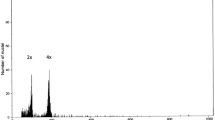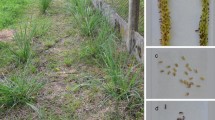Abstract
Lavandula angustifolia (lavender) is a small woody perennial grown for essential oil, which is steam distilled from flowers. To potentially improve size of flowers and oil yield we produced and characterised autotetraploid plants. L. angustifolia seed germinated in the presence of the mitotic spindle inhibitor colchicine at concentrations of 125 mg l−1 or less resulted in plants carrying sports with larger flowers. Propagation of two sports gave rise to putative polyploid cultivars C3/2 and C6/24. Direct chromosome counts in root tip cells of seedlings from four common cultivars of L. angustifolia and the seed lot from which C3/2 and C6/24 were derived was 50 whereas C3/2 and C6/24 had greater than 90 chromosomes indicating they were autotetraploid. Ploidy level assessed by flow cytometry (FCM) of nuclei showed that 12 cultivars of L. angustifolia had similar nuclear DNA content whereas C3/2 and C6/24 had double the amount of DNA confirming autotetraploidy. The genome size (1C-value) of a diploid L. angustifolia cultivar was estimated by FCM to be 0.90 (±0.07) pg. Morphological characteristics were measured in autotetraploid and control plants. Autotetraploids had thicker peduncles, larger flowers and larger seeds than diploids. Scanning electron microscopy revealed peltate glandular trichomes were larger in the tetraploids relative to diploids. Both tetraploid and diploid cultivars had complex non-glandular trichomes on leaves and sepals and two different types of capitate glandular trichomes were identified on leaves. Autotetraploid lavenders represent useful germplasm both for commercial oil production and future breeding.




Similar content being viewed by others
References
Bennett MD, Leitch IJ (2005) Nuclear DNA amounts in angiosperms: progress, problems and prospects. Ann Bot 95:45–90
Bewley JD (1997) Seed germination and dormancy. Plant Cell 9:1055–1066
Craig S, Beaton CD (1996) A simple cryo-SEM method for delicate plant tissues. J Microsc-Oxford 182:102–105
Dolezel J, Bartos J (2005) Plant DNA flow cytometry and estimation of nuclear genome size. Ann Bot 95:99–110
Dolezel J, Sgorbati S, Lucretti S (1992) Comparison of three DNA fluorochromes for flow cytometric estimation of nuclear DNA content in plants. Physiol Plantarum 85:625–631
Galbraith DW, Harkins KR, Maddox JM, Ayres NM, Sharma DP, Firoozabady E (1983) Rapid flow cytometric analysis of the cell cycle in intact plant tissues. Science 220:1049–1051
Hallahan DL (2000) Monoterpenoid biosynthesis in glandular trichomes of Labiate plants. Adv Bot Res 31:177–120
Hancock JF (1997) The colchicine story. Hortscience 32:1011–1012
Hartwell LH, Hood L, Goldberg ML, Reynolds AE, Silver LM, Veres RC (2004) Genetics from genes to genomes, 2nd edn. McGraw Hill, Boston
López-Pujol J, Bosch M, Simon J, Blanché C (2004) Allozyme diversity in the tetraploid endemic Thymus loscosii (Lamiaceae). Ann Bot 93:323–332
Masterson J (1994) Stomatal size in fossil plants: evidence for polyploidy in majority of angiosperms. Science 264:421–423
McGimpsey JA, Porter NG (1999) Lavender: a grower’s guide for commercial production, 2nd edn. New Zealand Food & Crop Research Limited, Christchurch
Otto SP, Whitton J (2000) Polyploidy incidence and evolution. Ann Rev Genet 34:401–437
Raev RT, Jordanov R, Zheljazov V (1996) Induced polyploidy in lavender. Acta Hort 426:561–572
Sharma AK, Sharma A (1999) Plant chromosomes: analysis, manipulation and engineering, 1st edn. Harwood Academic Publishers, Amsterdam
Taylorson RB, Hendricks SB (1977) Dormancy in seeds. Ann Rev Plant Physiol 28:331–354
Tucker AO (1981) The correct name of lavandin and its cultivars (Labiatae). Baileya 21:131–133
Upson T, Andrews S (2004) The genus Lavandula, 1st edn. Timber press, Portland, Oregon
Vinot M, Bouscary A (1971) Studies on lavender VI. The hybrids. Recherches 18:29–44
Werker E (1993) Function of essential oil-secreting glandular hairs in aromatic plants of the Lamiaceae—a review. Flavour Fragrance J 8:249–255
Werker E (2000) Trichome diversity and development. Adv Bot Res 31:1–35
Widén B, Widén M (2000) Enzyme variation and inheritance in Glechoma hederacea (Lamiaceae), a diploidized tetraploid. Hereditas 132:229–241
Zonneveld BJM, Leitch IJ, Bennett MD (2005) First nuclear DNA amounts in more than 300 Angiosperms. Ann Bot 96:229–244
Acknowledgements
The authors would like to thank the following: Rural Industries Research and Development Corporation (RIRDC), Canberra and Larkman Nurseries, Melbourne for financial support. Dr. Rosemary White, CSIRO Plant Industry Microscopy Centre, Canberra for assistance with SEM. Drs. Geoff Burrows and John Harper for comments on the manuscript and helpful discussion.
Author information
Authors and Affiliations
Corresponding author
Rights and permissions
About this article
Cite this article
Urwin, N.A.R., Horsnell, J. & Moon, T. Generation and characterisation of colchicine-induced autotetraploid Lavandula angustifolia . Euphytica 156, 257–266 (2007). https://doi.org/10.1007/s10681-007-9373-y
Received:
Accepted:
Published:
Issue Date:
DOI: https://doi.org/10.1007/s10681-007-9373-y




